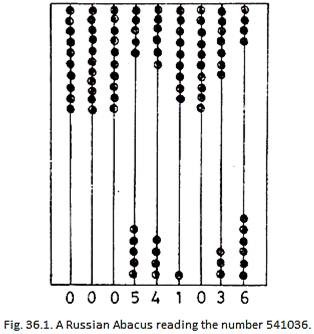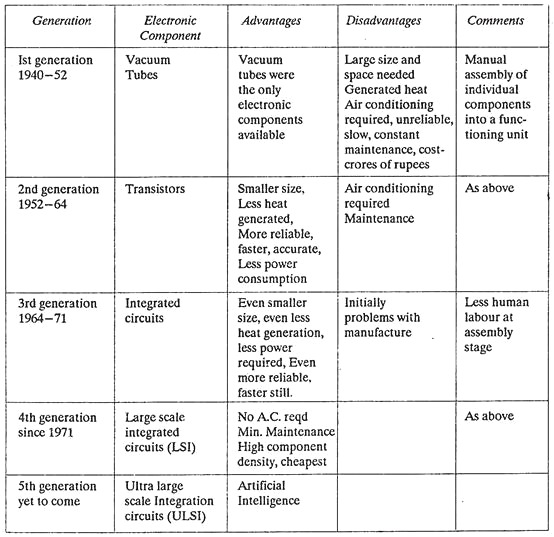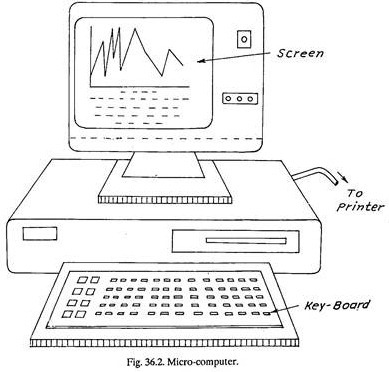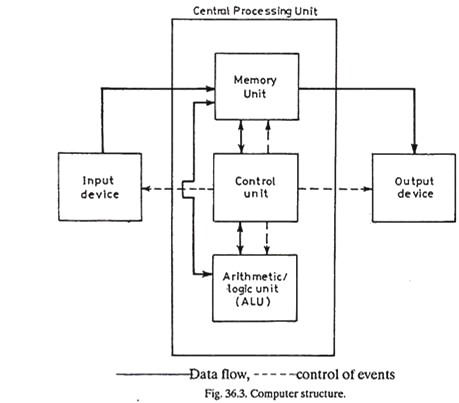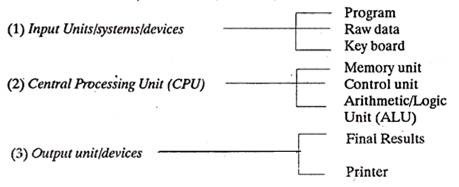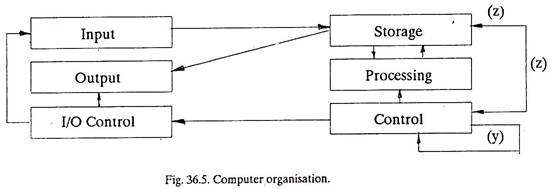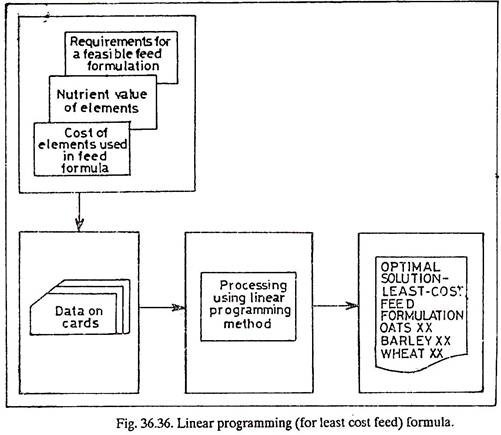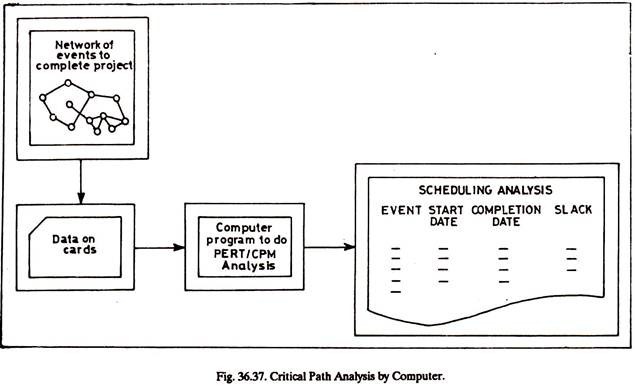Do you want to make an amazing science fair project on computers? You are in the right place. After reading this article you will learn about:- 1. Introduction to Computer 2. Characteristics of Computers 3. History 4. Generations 5. Classification 6. Structure 7. Organisation 8. Limitations 9. Applications.
Contents:
- Science Fair Project on the Introduction to Computer
- Science Fair Project on the Characteristics of Computers
- Science Fair Project on the History of Computers
- Science Fair Project on the Generations of Computers
- Science Fair Project on the Classification of Computers
- Science Fair Project on the Structure of Computers
- Science Fair Project on the Organisation of Computers
- Science Fair Project on the Limitations of Computers
- Science Fair Project on the Applications of Computers
Science Fair Project # 1. Introduction to Computer:
The advent of modernization turned the life of man more and more complex. So when his limited abilities surrendered before the mighty requirements, he realised the need of a device which was transcendently efficient and the solution was right in front of him – A Computer. A computer is an electronic device capable of performing a number of complex operations within no time.
It has internal storage (for the program and the data being operated on), a stored program and program modification capabilities. A computer is basically an automatic information convertor. It can transfer raw and unusable data into a meaningful information. A computer is utilized for processing a set of information.
ADVERTISEMENTS:
A computer is a data processor that can perform substantial computation, including numerous arithmetic and logic operations without intervention of 3 human operators during the run. Today computer is used by Government, public and private enterprise, and its technical and commercial applications reach ever further into the needs of modern communities.
In one role the computer will carry out routine tasks such as the preparation of company payroll, invoicing, or the auditing and monitoring of warehouse stocks, at another level it becomes a basic research instrument which is able to investigate, assess and isolate statistical information, or carry out engineering and scientific designs and calculations; and in yet a third role it is a means of stabilising and controlling complex chemical plants and other industrial processes such as power stations and smelting furnaces etc.
Coupled with a capacity to store data in memory banks, and to make any segment of this data instantly accessible to the user, computer systems are now an essential feature of social administration and provide industrial managements, in particular, with a powerful and important tool.
Science Fair Project # 2. Characteristics of Computers:
The main characteristics of the computer are:
(i) Speed:
ADVERTISEMENTS:
Electrical pulses travel at incredible speeds and, because the computer is electronic (and not tied down to mechanical movements, turning of wheels, slipping of clutches and gears), its internal speed is virtually instantaneous.
We do not talk in terms of seconds or even, today, of milliseconds (thousandths of a second). Our units of speed are the microsecond (millionths), the nanosecond (thousand-millionths) and even the picosecond (million millionths).
(ii) Storage:
As a human brain retains important things in its memory and relegates unimportant details to the back of the mind, the computer also stores certain amount of information in the internal memory of CPU (Central Processing Unit) and other data can be stored outside the memory of the CPU, on auxiliary or secondary storage devices, usually magnetic tape or disk.
(iii) Accuracy:
The accuracy of Computers is consistently high. Almost without exception, the errors in computing are due to human rather than to technological weaknesses.
(iv) Versatility:
ADVERTISEMENTS:
Computers seem capable of performing almost any task, provided that the task can be reduced to a series of logical steps.
The computer actually performs the following four basic operations and many daily activities can- be reduced to an interplay between these functions:
1. It exchanges information with the outside world via input/output devices.
2. It transfers data internally within the CPU.
ADVERTISEMENTS:
3. It performs the basic arithmetical operations.
4. It performs operations of comparison.
(v) Automation:
A computer is automatic (unlike a calculator which requires human operators to press the necessary keys for the operations to be performed). In computer once the process has begun, it would continue without the need for human intervention until completion.
(vi) Diligence:
Computer, being a machine, does not suffer from the human traits of tiredness and lack of concentration. If 4 million calculations have to be performed, it will perform the 4 millionth calculation with exactly the same accuracy and speed as the first.
Science Fair Project # 3. History of Computers:
The use of fingers was the first method of counting. The Stone-age man used pebbles for counting. Having found that fingers or the quantity of pebbles were not able to cope with increased requirements of computation, the man employed other methods for computation such as scratches on stones, trees etc. The process required further perfection and a sort of adding machine called ABACUS was invented in China about 400 B.C. An abacus consists of a rectangular wooden frame with wires, which carry similar round beads. Counting is performed by shifting the beads from one side to the other (Fig. 36.1).
In 1617, a Scots mathematician Napier invented Computing-rods which are called Napier’s Bones. There are a set of eleven rods having four faces, with numbers marked on them in such a way that by simply placing the rods side by side, products and quotients of large numbers can be obtained. Napier also invented logarithm, which is still used by some students to do complex arithmetical calculations.
Napier’s invention of logarithms led to the development of the Slide Rule in the year 1632 by English Mathematician William Ought-red. Slide rules were used extensively for doing calculations (until the electronic calculators were introduced). You would have seen some mechanical calculators being used in some offices, provision shops or super markets to add or subtract numbers and prepare bills for the customers.
These machines were first invented by Blaise Pascal in 1642. The machine invented by Pascal was limited to addition and subtraction. Gottfried Liebniz (1646-1716) later improved upon Pascal’s machine to do multiplication and division. Incidentally Liebniz was the first to recognize the true potential of the Binary System. Joseph Marie Jacquard in 1801 invented the first punched-card machine.
ADVERTISEMENTS:
The pattern woven by the loom was determined by the placement of holes in a control card; only those threads whose guiding hook encountered a hole in the card could enter the pattern. In 1822 Charles Babbage of England known as the father of Computers, invented a machine which he named as Difference Engine, in order to automatically perform simple computations needed for trigonometric and logarithmic tables.
Inspired by automatic Jacquard looms, Babbage proposed an Analytical Engine which had four components:
(i) Storage device.
(ii) Arithmetic unit.
ADVERTISEMENTS:
(iii) Control unit.
(iv) Input-output device.
This concept is still used in our modern computers.
Due to the limited technology available at those times, Babbage was not in a position to build Analytical Engine. In 1855, George Scheutz, a Swede, made a machine based on Babbage’s principles and drawings. In 1889, Dr. Herman Hollerith of America developed the idea given by Jacquard and introduced the world with the punching of cards as a means of coding.
Numbers and alphabets were punched on the cards by holes. These cards were mounted on machines which after reading these cards, operated accordingly. In 1896, Hollerith formed his own company, The Tabulation Machine Company which, however, he sold in 1911. It merged with two other companies to form the Tabulation Recording Company by 1924, this company became the International Business Machines (IBM), the largest manufacturer, even today, of computers.
During the years between 1920 and 1930 the punched card system developed steadily not only in USA but also in Britain and other parts of Europe. During Second World War (early forties) development in computer science took place at a faster rate.
ADVERTISEMENTS:
Computers were used to understand the code of enemy and for designing aircrafts. Computerized radars were also made. In 1944, an American Howard Aiken developed a computer, which he called as Mark-I. This computer was based on the principles of electronics. It was capable of performing five basic operations—addition, subtraction, division, multiplication and table reference. It was extremely slow by present day standard.
It was very noisy, bulky and its size was 15 m x 0.6 m x 2.4 m (I x w x h). Present day fourth generation microcomputer can be mounted on a table measuring 1.2 m x 0.7 m. In Mark-I the input and output were by punched cards and paper tapes.
Soon after Mark-I, Aiken himself introduced the world by Mark-II, Mark-Ill and Mark-IV computers which were some improved versions of their predecessors. In 1946, University of Pennsylvania developed Electronic Numerical Integrator and Calculator (ENIAC) which was the first electronic computer of the world. ENIAC weighed about 27 tons, occupied a room 15 m x 9 m, contained 18000 vacuum tubes, 1500 relays and consumed 150 kW of electricity. It could perform 5000 additions in one second.
The addition of two numbers was achieved in 200 microseconds and multiplication in 2800 microseconds. The internal operations of this machine were conducted by electronic impulses generated at a rate of 100,000 per second. Neumann was the first to introduce the stored program concept in the computer. Based on Neumann’s idea, between 1947-1950, the Moore School personnel and the Ballistics Research Laboratory of U.S. Army built the computer EDVAC (Electronic Discrete Variable Automatic Computer).
Another Computer using internal storage, called EDSAC (Electronic Delay Storage Automatic Computer) was completed in 1949 at the University of Manchester (England). EDSAC was of some significance since it was the first computer to contain a changeable program of instructions within its own memory.
Science Fair Project # 4. Generations of Computers:
The growth of computer is studied in five distinct phases (or age groups). These age groups are called generations of Computer. The different generations are characterized by their technology of basic Computing elements.
ADVERTISEMENTS:
The different elements are:
(i) Valve.
(ii) Transistor.
(iii) Integrated circuit.
(iv) Micro-processor chips or VLSI Chips.
(v) Large Scale Inference Systems.
(i) First Generation Computers (1940-1954):
The first generation computers used diodes or triode valves (or vacuum tubes) for the electronic components and the copper wire for connecting different components of a Computer. It used either electrostatic tubes (CRT) or mercury delay lines for storage.
Computers of first generation are:
1. ENIAC was the beginning of the first generation computers. There were 18000 vacuum tubes, 70,000 resistors, 10,000 capacitors and 60,000 switches in it. It consumed 150 kW of electricity.
2. EDSAC built by M.V. Wilkes at Cambridge University in 1949.
3. ED VAC built at Pennsylvania University in 1950.
4. Lyons Electronic Office (LEO), the first Commercial Computer produced by M.V. Wilkes in 1951.
ADVERTISEMENTS:
5. Universal Accounting Company-1 (UNIVAC-1) produced in 1951 by Universal Accounting Company set up by Eckert and Mauchly.
6. 1BM-701 and IBM-650, were introduced in 1953 and 1954 respectively by International Business Machines Corporation (I.B.M.). The IBM -650 was the first modern digital computer produced on the mass scale.
(ii) Second Generation Computers (1952-64):
The second generation machines were initially marked by either magnetic drum or magnetic core storage and, later, by the use of the Transistor in place of vacuum tubes. Because transistors were much smaller in size, the Computer became compact and consumed less power. In place of copper wire connections, the components were fixed on printed circuit boards.
As a result computers became smaller in size, cost came down, the speed increased manifold, and the emission of heat was greatly reduced. Second generation computers were used for scientific and mathematical applications as also for business type applications. By 1960, U.S.A. alone had more than 5000 computers.
Some of the second generation computers are:
IBM-1401 was the most popular of second generation computers.
(iii) Third Generation Computer (1964-1971):
ADVERTISEMENTS:
Computers of third generation were made still smaller with larger capacity, by using small ceramic plates on which the integrated circuits were produced. These computers were characterized by integrated circuits, improved secondary storage devices and new input-output devices like-visual display units (V.D.U.) and high speed printers. These computers were called Mini Computers.
The solid state discrete components (e.g., instead of having one transistor of its own, several transistors could be integrated with the other components) were packed into integrated circuits (IC). The IC was invented by Jack Kiby at Texas Instruments in year 1958. These computers used integrated circuits built on wafer-thin-stices of extremely purified silicon crystal popularly known as chip. These computers used integrated circuits.
The technology used was Large Scale Integration. Each I.C. incorporated hundreds of Transistors. In addition to computers main memory, secondary or auxiliary better storage devices were developed. These devices made multi-purpose and multi-programming possible. Improved input/output devices such as VDU’s, and High speed printers were used. Third generation Computers were of small size, low cost and large memory.
Some of such computers are:
(iv) Fourth Generation Computers (Since 1971):
With the development of Micro-processor chips or large scale integrated circuits (LSIC) and very large scale Integrated Circuits (VLSIC) in 1971 by Intel Corporation of USA, another breed of computers known as Micro Computers came into existence in 1974 and became popular as fourth generation of computers.
Altair was the first Micro-Computer designed by Ed. Roberts, President of MITS. In 1970, an Englishman Clive from Cambridge designed the smallest and cheapest computer available at that time-called Personal Computer Sinclairs ZX-80. It could be linked with a TV set for visual display. The first pocket computer Sharp PC 1211 was sold by Japan in year 1980. The Apple series of micro-computers was developed by Steve Wozniak and Steve Jobs in 1976.
This used 8 bit microprocessor chip. The chip enabled to put together a complete computer, a key board for input, a processor and few thousand characters in memory and screen; all in a small box. Fourth generation computers are of small size. They can occupy an office Table only with all its peripherals (external parts of a computer). The capacity of such computers is unimaginably large due to ultra-high capacity storage devices.
These computers have:
a. Excellent speed,
b. Reliability, and
c. Low cost.
Some of fourth generation Computers are:
a. Intel 4004
b. Apple I and II
c. DCM Spectrum-7
d. ZX-Spectrum
e. BBC’s Accorn
f. IBM Compatibles etc.
g. Sinclairs ZX-81
(v) Fifth Generation Computers:
The fifth generation is the story of the new super-breed of computers now being planned by the Japanese. Research is going on using Ultra Large Scale Integration (ULSI) technology. The result of this technology is a super chip.
The fifth generation computers will:
1. Have ability to understand normal human speech.
2. Be able to conduct a dialogue with users by means of synthesized speech.
3. Have ability to perform intelligently to human queries.
4. Have ability to learn from experience of the past.
Artificial intelligence (A.I.) is the main charm for these computers. The fifth generation computers, once developed, will have three sub-systems.
(a) External interface of basic software system.
(b) Basic software system.
i. Problem solving
ii. Knowledge base,
iii. Intelligent interface
(c) Hardware system.
Science Fair Project # 5. Classification of Computers:
Computers in general are of three types based on their function (the way they work i.e., operations):
2. Analogue Computers.
3. Hybrid Computers.
1. Digital Computers:
A computer which operates essentially on digits and numbers is known as digital computer. Digital computer accepts data in the form of digits, subjects the data to mathematical processing, and finally presents the user with a result based on these operations. Digital computers represent numbers by discrete coded pattern (e.g., digital data), such as perforations in card or presence of pulses.
Mathematical expressions are finally represented by Binary digits (0 and 1) and all operations are done using these digits at very high rate. A digital computer operates on inputs that are on-off or incrementally-stepped quantities which are represented by numerical digits. The digital computer incorporates an electronic memory.
This is, in fact, an information store which may be activated at any point to influence or modify the calculations in hand. Digital computers have vast applications and are the most popular. They are useful for evaluating arithmetical expressions, such as solution of quadratic equations or simultaneous equations, preparation of budgets, bills, payrolls etc. Generally the digital computer is applied to the processing of business and administrative data.
Digital computers can be further classified in accordance with their memory-size as follows:
Each information which is to be stored in the Computer’s memory is coded into some special combinations of zeros and ones.
The digits 0 and 1 are called BITS (a contracted combination of BInary and digiTS). Every BIT is represented by electronic switches where on switch represents 1 and off switch 0.
1 Byte (b) = 8 or 23 BITS.
1 Kilobyte (Kb) = 1024 or 210BITS.
1 Megabyte (Mb) = 1024 or 210 Kilobytes.
WORD is a group of BITS, the length of which varies from computer to computer, but it is predetermined for each computer machine. The WORD-length may be as long as 60 BITS or as short as 8 BITS.
(i) Super Computer:
Super Computer is a main frame computer. Super computers are generally used as Net-work Computers, e.g., accounts in a branch bank can be controlled by a Super Computer in head office, World-wide Airlines reservations can be controlled etc.
(ii) Main Frame Computer:
Main frame computer occupies a large air-conditioned roomful space. Since all its peripherals are mounted in large cabinet type of frames, it is called Mainframe computer. This computer can be used by 128 users simultaneously in lime sharing mode. The main memory size of this computer is upto 128 Mb. In respect of storage and processing capacity, main frame computer is the strongest one.
It is used when very voluminous computations are to be carried out in a very short time. Computations regarding the flight of artificial satellites cannot be taken up on a micro or minicomputer. All the first to third generation computers which work with the speed of 5 to 100 million instructions per second fall under this group.
Some of the examples of main frame computers are:
IBM 308-580 series
IBM 4300, 4381
DEC 1090
UNI VAC 1100, 70
ACOS 100
(iii) Mini-Computers:
A mini Computer is in between the main frame computer and the micro-computer. The storing and processing capacities of mini-computer are greater than that of micro-computer. Mini Computers are at least 5 times more faster than micro-computers having CPU speed of approximately 500 kilo instructions per second.
In comparison with main frame computer, the capacity of mini-computer is smaller. The bytes used in mini-computer comprise of 16 bits. Some mini computers also have bytes of 32 bits. In mini-computer, there is also provision of a key-board for insertion of data and program. The final results are displayed on the screen of minicomputer.
Some of the mini computers are:
TDC-316, 332
IBM-9370.
(iv) Micro-Computers:
A micro-computer is called so because of two reasons one, because it is miniature in size and another because it uses microprocessor. A micro-computer does not occupy much space, its maintenance is easy and it is less costly than the mini or main frame computers.
The entire CPU of microcomputer is contained in a single silicon micro-chip of thumb nail size called microprocessor. A micro-processor unit is not a complete micro-computer, because a micro-processor does not contain memory unit, input unit and output unit. Therefore when equipped with memory and input/output control circuits the micro-processor is known as microcomputer.
In some micro-computers, even the memory, and the input/output unit are also contained in the same chip. This further reduces the size of the micro-computer. Early micro-computers had a word length of 8 BITS but currently 16 BITS micro are available.
The speed of the micro-computer is of the order of 100 Kips (Kilo Instructions per second). Micro-computers are suitable for a medium sized organisation, colleges etc. They have generally a visual display unit, key board, one or two floppy disk drives and printer (Fig. 36.2). Some of the micro-computers are Z X 81, BBC Acron etc.
2. Analog Computers:
An analog computer is one which solves the problems by preparing analogue models of mathematical equations of physical phenomenon. Analogue ox Analog means establishing similarities between two quantities.
In analog computers, similarities are established in form of current or voltage signals. Analog computers use electronic circuitry to represent physical processes, with changes in electric current representing the behaviour of the system being studied.
Analog computers operate by measuring, whereas digital computers operate by counting. Whereas digital computers work on discrete (digital) quantities, analog computers work on continuous quantities such as length of rods, voltage across terminals, forces in springs etc.
While using an analog computer, a physical system is first converted into equations which are then further converted into analogue electrical signals. The arithmetical operations are performed electrically using small signal amplifier blocks. The results so obtained are then decoded into mathematical form or in the form of graphs.
An analog computer is used in the investigation of physical systems and simulates—i.e. creates an analogue of the elements of these systems, by means of synonymous electrical voltages. Permutations of these voltages represent changes in the system and hence can be manipulated to reproduce the variety of situations under study. The analog computer, therefore, accepts and processes data in the form of continuously variable physical quantities.
An analog computer:
(a) Sets up analogy of problem,
(b) Represents physical variable by continuous measurement of analogous quantity (e.g., voltage, shaft rotation etc.),
(c) Is best suited to represent measurable quantities and simulate response of physical systems by mathematical analogies,
(d) Does not have good accuracy.
By analog computer method, it is easy to get graphical results directly. They can solve differential equations can find not only real roots but complex roots also of a polynomial. The analog computer, because it has only a limited memory facility and is restricted in the type of calculations it can perform, can only be used for certain specialised engineering and scientific applications.
3. Hybrid Computers:
Design features of Analog and Digital Computers can be combined to create a Hybrid Computer. In this form of computers, a single machine is equipped with both Analogue and Digital capacity. In hybrid computers, some calculations are done in analog portion of computer and some are done on digital portion of the same computer.
Then it utilizes the services of the devices which convert analog signals into digital, and digital signals into analog wherever necessary. Hybrid computers are specialised machines intended for special-purpose applications and, as such, are not generally encountered by the public. Hybrid computers are most expensive computers and are used in most sophisticated areas such as space flight, dropping of bombs on the targets, monitoring of the space activities etc.
Some hybrid computers are:
Apple II
TDC-3000
BBC series
Most Modern Computers are digital computers and it is usually digital computers that are referred to when the word Computer is used. Digital computer is the everyday unit to be found in modern commercial and industrial undertaking.
Science Fair Project # 6. Structure of a Computer:
A computer essentially consists of the following functional elements/constituents/basic components:
The parts of the computing machine which are involved in the transfer of data to and from the outside world are known as peripheral devices e.g., (1) and (3) above.
(i) Input Unit and Devices:
If a person has to use the Computer to solve his problem, he will have to make computer understand his problem in the language which the computer can understand.
The input unit:
(a) Accepts the data or the program of instructions given by the user, and
(b) It converts the data/instructions from man readable form to machine (computer) readable code.
Input devices are used to transfer the information into the computing machine. The most commonly used input device is the punched card reader. The input medium in this case is punched card. Paper tape readers are used as input device when input data has been placed on punched paper tape. Magnetic character readers are used mainly in banks for cheque processing.
Optical scanners are becoming more popular, especially for reading ticket-type data, such as gasoline charge tickets and airline tickets. To conclude, the function of the input unit is to feed the data and program to the memory unit of C.P.U. Actually, input and output units are meant for creating communication between the user (man) and computer.
(ii) Central Processing Unit (CPU):
CPU is popularly called as the Heart (memory unit), Brain (ALU) and Nervous System (control unit) of the computer. It provides central control of the functions of the whole computing machine. It is the computer part of the computer system.
Functions of a CPU are:
(a) To store data as well as program (instructions).
(b) To control the sequence of operations as per the stored instructions.
(c) To issue commands to all parts of the computer system.
(d) To carry out data processing and send results to output unit. Data processing implies the processing of information (specially business type information) by computer.
CPU contains:
(i) A memory unit,
(ii) A Control unit, and
(iii) An Arithmetic and Logic Unit (ALU).
(i) Memory Unit:
Memory unit of the CPU is a place where the Computer Program and data are stored during processing. It is a random access storage device, consisting of a number of storage locations, each storage location being identified by a unique number, called as its address.
The data that are to be stored in the memory unit for processing are fixed by the computer program, and the particular storage locations which are to receive these data are assigned when the program is loaded into the memory.
Normally, each data item called as a field is assigned to a particular storage location so that the item may be directly accessed, by means of the address of the storage location. The Main or Internal Memory (called Primary storage also) usually contains the program being executed and the data required by that program.
The commonly used devices of main storage memory are:
(a) Magnetic core memory,
(b) Thin film memory,
(c) Thin rod memory, and
(d) Plated wire memory.
Main memory stores the following:
(a) Instructions waiting to be obeyed by other components of the CPU.
(b) Instructions currently being obeyed.
(c) Data awaiting processing.
(d) Data currently being processed.
(e) Processed data awaiting output.
The information required by the computer for its immediate needs is stored in the Internal Memory while the rest of the information is stored on Secondary storage devices. Secondary storage also called Auxiliary storage is supplementary to the primary (Internal) storage associated with the CPU. Secondary storage is used to hold programs and data file and has large capacity storage relative to the internal memory.
When a data record or program is to be used in processing, it is copied from the secondary storage into the primary storage. After processing, the updated record is stored back in its storage position in the secondary storage.
Punched cards can be used for secondary storage, but magnetically encoded storage media is usually more desirable, because data once written on them, after being used, can be erased and new data can be recorded in place of old one as in a home tape recorder.
The most popular magnetic storage media are magnetic tape and magnetic disk. The storing capacity of main (internal) memory unit of computer is limited but the capacity of secondary stage is practically unlimited. The data which are to be used rarely and are voluminous in size are kept in secondary storage.
(ii) The Control Unit:
The control unit directs all operations inside the computer. It is known as the nerve centre of the computer because it controls and co-ordinates all hardware operations. Referring to Fig. 36.3 the program (instructions) and data are transferred, under the direction of the control unit, from the input device into the memory. During program execution, each instruction is retrieved in turn (proper sequence) from the memory and interpreted.
Control unit informs the (Arithmetic/Logic Unit) ALU of the precise operation to be performed and directs the transfer to the ALU of any item of data which is needed for the operation. The ALU then executes all calculations and comparisons. Results destined for output are then passed to memory where they are held in storage temporarily, prior to presentation by the output device.
This procedure also takes place under the direction of the control unit. The control unit may be a hardwired control or a micro-programmed control. To summarize, the control unit is designed to coordinate the representation, storage and internal movement of instructions and data, as well as the interpretation and subsequent execution of those instructions, and it then has to pass on the results.
(iii) The Arithmetic /Logic Unit (ALU):
The ALU comprises of a number of accumulators and registers. The ALU derives all the data from the main (internal) memory as directed by control unit based on program given to it. This data gets loaded into accumulators in the ALU.
The ALU operates on the data available in the main memory and sends it back after processing, once again to main memory for onward transmission to output unit/device. ALU is that part of CPU where all the arithmetical and logical operations are performed. Constructed from high speed electronic components, ALU is a sophisticated piece of circuitry which will perform some specified operation on the data presented to its inputs.
Typical of the operations that an ALU is able to perform are:
(1) It carries out arithmetical operations such as addition, subtraction, multiplication and division.
(2) It performs certain logical operations based on AND, OR, EXCLUSIVE, OR
(3) Manipulation operations such as SHIFT, TEST.
(iii) Output Unit and Devices:
The function of the output devices is to get (results) information out of the CPU. The output unit (Fig.36.3) receives the results of processed data from the main memory unit. These results are in binary signals. Therefore provision is made in the output unit so that the results, given in binary units, may be translated into understandable language.
Various Output devices are:
a. Line Printers.
b. Visual Display Unit (VDU).
c. Punched cards.
d. Punched tape.
e. Magnetic tape unit.
f. Magnetic disk unit etc.
Science Fair Project # 7. Organisation of a Computer:
Fig. 36.5 shows the basic arrangement for computer organisation.
The main features of this organisation structure are:
1. Input and output units are directly connected to storage (memory). This will free the processing unit from the necessity of waiting while input and output data move through them.
2. An additional subsidiary (I/O) control unit has been provided to work under the direction of (main) control unit and to assist it.
3. The control unit has the power to change the sequence of instructions it gives to different units of the computer organisation. This is achieved by adding a further line of communication (y) in the circuit (Fig 36.5).
4. The control has been provided with direct access with storage, using the line of communication (z). Thus, the control will have added ability for READ and REMEMBER information it is processing. This (arrangement) may be called stored programme arrangement.
Science Fair Project # 8. Limitations of Computers:
(i) Computer finds itself helpless in the areas involving creative thoughts and the development of original ideas. The computers up to 4th generation do not have any thinking and decision taking ability.
(ii) Computer parts require regular checking and maintenance in order to give correct results.
(iii) Computer needs a dust and traffic free place of installation.
(iv) Due to very fast working, some parts of Computer get heated up. They are required to be kept cool, otherwise they may stop functioning. This needs the workplace to be air-conditioned.
(v) The output of the computer depends upon the skill of the programmer. The mode in which the computer has to perform and the sequence in which the data is to be processed to solve a particular problem are the things that are decided by human brain.
(vi) Computer is a costly item beyond the reach of every user.
Science Fair Project # 9. Applications of Computers:
Computer find application in many walks of life. Their applications mainly in the following fields will be discussed in this article: 1. Scientific 2. Business 3. Data processing and 4. Production.
(i) Scientific Research:
In science, the advent of computers has meant that, calculations which were previously beyond contemplation, because of the time-span and drudgery involved in carrying them out, have now become possible. This has greatly accelerated and expanded research in such sciences as physics, chemistry, astronomy and genetics.
More recently there has been an increasing use of computers for research and data analysis in less mathematical areas such as medicine, the social sciences and even the humanities where applications include concordances, textual criticism and stylistic analysis.
Computers are now a standard feature of life in universities and industrial laboratories. Almost every branch of science and engineering has benefited from their development. Elementary particle physics is one field of study which has been broadened considerably. Molecular biology is another, resulting in spectacular progress in our understanding of the structure of living matter.
(ii) Business Applications:
Computer applications to business and commerce date from the middle of the 1950’s. The pace of the technology has since quickened and today most large and some medium sized companies are dependent on their computers for administrative functions.
Micro-electronic technology is enabling offices to function more efficiently and micro-computers are used, now-a-days, by various concerns:
(a) In business forecasting.
(b) To keep records up-to-date.
(c) To carry out automatic checks on the stock of a particular item.
(d) To prepare pay bills and personnel records.
(e) In accounting, invoicing and billing.
(f) In banking operations and data storage.
(g) In business correspondence and communications.
(h) In functions of various types in Life Insurance Business.
(i) As an aid to management, etc.
(iii) Data Processing:
Although computers were initially designed to solve scientific problems, the bulk of computing today is concerned with data processing, which covers a wide field of applications relating to commercial, governmental and industrial tasks. The purpose of discussing data processing is that it brings us back to a major concept, namely that computers process information.
Data processing means the processing of information, specifically business type information, by computer. Almost any organisation has a certain amount of administrative work that used to be carried out manually- staff must be paid, raw material has to be ordered, records have to be maintained of the personnel employed, the tax deducted from their pay, suppliers, orders placed with suppliers, customers, customer’s orders etc., in order that the organisation may work efficiently and meet its legal obligations.
It was during the 1950s that the term data processing came into widespread use to describe all these administrative processing and record-keeping functions. Although the activities included in the term data processing were diverse, they nevertheless shared some common features.
Among these were:
1. Need to maintain accurate records and files.
2. Need to sort, merge and tabulate the records in the files.
3. Need to carry out basic calculations.
4. Large volume of records handled.
5. Routine and repetitious nature of much of the manipulation performed on the records.
Given the above features, it was natural that machines should be developed to help in the processing of data with the objectives of improving accuracy, reducing tedious manual work, speeding up the work and, above all reducing the costs involved.
The machines used for data processing until the 1950s were mechanical or electro-mechanical. In 1951 the world’s first commercial data processing computer was developed by British food company Lyons to perform some of the commercial tasks described above.
A period of rapid development followed and a significant point was reached in 1959 when IBM introduced the 1401 computer. With the widespread use of computers for data processing work,- the terms Electronic Data Processing (EDP) and Automatic Data Processing (ADP) came into use to distinguish data processing carried out using the new tools from that using the (then) conventional tools.
The flexibility of computers has also caused the scope of the term data processing to be broadened and today it often includes such activities as:
(i) Scheduling the work to be performed in manufacturing plants,
(ii) Calculating statistics,
(iii) Monitoring the performance of industrial plant or machinery, and
(iv) Analysing a wide range of technical facts and figures.
The study of data processing is actually the study of the organisation and techniques for the collection, processing, storage and output of data. We shall now briefly examine the steps by which information (current and past paperwork) is expressed as data, processed and returned to managers, as updated and useful information.
There are basically five steps:
a. Preparation of source documents,
b. Input of data,
c. Manipulation of data,
d. Output of information, and
e. Storage of data.
a. Source Documents:
The first step is to obtain the relevant facts and figures and to set these out on source documents. For example, in a population survey, the name, address, age, sex, occupation etc. must be first written down onto a survey sheet.
b. Data Input:
Once the data has been extracted from the source document, it must then be transposed into some form suitable for entry into the computer so that processing can take place. The method will depend upon the input device e.g., punched cards, paper tape, VDU etc.
c. Manipulation of Data:
Information, input as data, for processing, may have to be classified or sorted. It is this data manipulation, rather than pure computation, with which data processing is mainly concerned. For example, in the population survey, we may want to classify people by age. All these forms of data manipulation will produce results in the form of summaries e.g., the number of adults and children in a given town, etc.
d. Output of Information:
The object of outputting results or summaries is to provide meaningful information to all concerned. The summaries should be such that they can be digested easily and quickly.
e. Data Storage:
In most cases, the results of processing (one set of) data are retained for future use or reference.
(iv) Industrial Applications/Production:
Computers are used to direct the operation of individual machine tools (drills, lathes etc.) and also to operate assembly machines. The use of numerically controlled machine tools directed by computer-produced tapes can speed up production, ensure greater precision and reduce scrap. In certain industries e.g., chemical, oil refining etc., the computer can be used to monitor and regulate total processes (i.e., to perform process control) without human intervention, just as it can control air-conditioning (and heating) systems in modern multi-storey buildings.
The design calculations of any piece of engineering, whether an aeroplane, ship, car, bridge, road, building or machine, can be done by computers. Moreover, the computer can evaluate the alternatives more quickly and more accurately than would otherwise be possible. This means a great saving in time and elimination of technical faults and human error. Computers are also used in calculations of space and layout as well as strength requirements.
Computer can also help with graphical display, the creation of drawings and schematic drawings. Computers are also used as an aid to circuit board design, even assisting electronic engineers in designing circuits for other computers. The application of computers to design is known as CAD (Computer-aided design) and where it applies specifically to engineering, it is often referred to as CAE (Computer-aided engineering).
CAD makes use of a computer to interact with a designer in developing and testing product ideas without actually building prototypes. The computer assists in the design of an individual part or a system such as an aircraft. The design process usually involves computer graphics. In industry, production may be planned, coordinated and controlled with the aid of a computer.
Computer may be used to assist in:
(a) Inventory control.
(b) Product scheduling.
(c) Line balancing.
(d) Network analysis (PERT and CPM).
(e) Operations research problems (Linear programming such as transportation problems, waiting line theory, etc.).
The solution of a linear programming problem of a good size and complexity involves hundreds of thousands of simple repetitive calculations which would be impractical without a computer. In fact, linear programming methods were developed specifically to take advantage of computer technology.
Linear programming is used by business firms to find the optimum solution to such problems as the least-cost blend of ingredients for feed (Fig.36.36), the most profitable combination of oil refinery production, and the most economical shipping schedules.
Critical Path Analysis (CPM/PERT) by Computer:
The scheduling of projects with interdependent activities can become quite complex. Computer programs have been written which analyze activities in order to calculate which are critical to the timely completion of a project and which can take longer than expected time without delaying the completion date. This technique is called PERT, CPM, or critical path scheduling.
